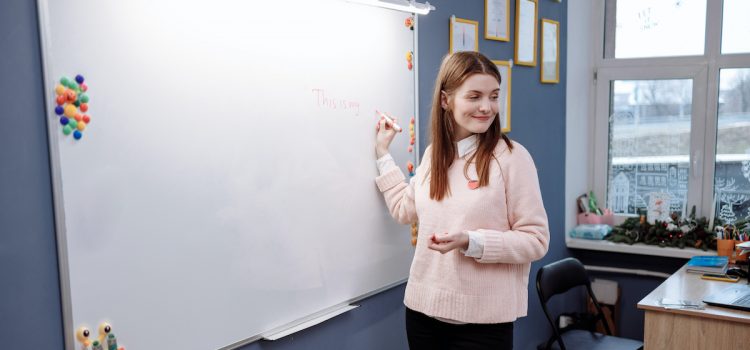

This article gives you a glimpse of what you can learn with Shortform. Shortform has the world’s best guides to 1000+ nonfiction books, plus other resources to help you accelerate your learning.
Want to learn faster and get smarter? Sign up for a free trial here .
Do you want to make a lasting impression on your students? What are the qualities of an effective teacher?
Teachers are among the most important people in our lives. Not only do they prepare children for the real world, but they set students up for success and provide them with valuable skills.
If you want to be someone who positively impacts the lives of students, uphold these six qualities of an effective teacher.
1. Problem-Solver
Being a problem-solver is a quality of an effective teacher. Issues, such as a conflict between students or a shortage of school supplies, arise at school that teachers will have to fix on their own.
There are five steps to problem-solving, as written by the authors of Critical Thinking, Logic & Problem Solving, that teachers can apply in the classroom:
- Identify the problem. To solve a problem, you must first identify it. You can do this using seven basic questions that make what’s called the “5W2H” method (five ‘W’ questions and two ‘H’ questions):
- What? What is your current state, your desired state, and the gap between them?
- Where? What is the location of your problem?
- When? When did or does the problem occur? Is it ongoing? Will it happen again in the future?
- Who? Which people are impacted by the problem? Who caused it? Who may know more about it?
- Why? Why did the problem occur or why does it continue to occur? Why is the problem important to address?
- How? How could you solve the problem? What process should you use?
- How much or how many? How big is the problem? How much harm is it causing? How long will it take to solve?
- Form solutions. Visually lay out potential solutions so you can consider them more easily. Consider the benefits and consequences of each solution.
- Select a solution. Use a pros and cons assessment to rate each solution and decide which one would be the best option.
- Implement your solution. It’s now time to put your solution into action. You can use the 5W2H method again to help implement your plan:
- What solution are you going to implement?
- Why is this the best solution?
- Where will it be implemented?
- When does it need to be implemented?
- Who is going to implement it?
- How will it be implemented?
- How much effort or cost will it require?
- Evaluate the results. Note what went wrong and what went well, and use that information to make better decisions in the future.
2. Mentally Tough
School isn’t exactly a stress-free zone for teachers. Whether you’re dealing with loud kids, you have a lot of papers to grade, or administration is frustrating, you’re going to experience stress. To combat this stress, you need to be mentally tough.
In The Mental Toughness Handbook, Damon Zahariades defines mental toughness as strength and fortitude in the face of stress and obstacles. Mental toughness centers on your ability to effectively manage negative emotions like anger, fear, and sadness so they don’t control and lead you to make bad decisions. It also reflects your persistence and resilience in moments of hardship. Mental toughness isn’t something you’re born with, but a state of mind you can cultivate with patience, passion, and hard work.
You can see the perks of mental toughness in the behavior of mentally strong people. Like them, when you become mentally tough, you’ll be able to:
1) Act rationally and confidently under duress. Mentally tough people are attuned to and resist negative emotions like anger, fear, sadness, and anxiety, as well as negative self-talk. When you refuse to allow negative feelings and critical thoughts about yourself to consume you and cloud your judgment, Zahariades says you’ll avoid making poor decisions or quitting altogether. Instead, you’ll be able to think with a clear head and stay the course.
2) Maintain a clear focus. Mentally tough people know the underlying reasons they’re pursuing their goals, and they don’t allow their need for immediate gratification or their emotional pain to derail them. When you cave to your impulses or let past mistakes and grievances haunt you, you don’t have the time or energy to stay focused on what you’re trying to achieve. Understanding the purpose of your actions serves as a grounding force that you can remind yourself of when you encounter roadblocks, making you more likely to persist and achieve your goals.
3) Have a positive yet realistic mindset. This mindset enables mentally tough people to function at their highest level. It’s rooted in the fact that they accept that: a) the world is unpredictable, b) obstacles, setbacks, and change are a natural part of life, and c) the way to make progress is by confronting these realities head-on. When you have this mindset, Zahariades says, you can remain realistic yet positive in the face of uncertainty, look for opportunities and hope where others don’t see it, and make the most of bad situations.
4) Be resilient in the face of setbacks and failure. Mentally tough people recognize that disappointment, mistakes, and failure are natural parts of life, seeing them as opportunities to learn and grow. When you stop seeing failure as a reflection of your adequacy or worth, Zahariades says you’ll be more open to taking risks and trying new things—and you’ll feel less defeated each time you hit roadblocks, which will help you bounce back more quickly.
3. Good Leader
Another quality of an effective teacher is their ability to be a good leader for their students. According to James M. Kouzes and Barry Z. Posner in The Leadership Challenge, when people are asked to name the person who represents true leadership to them, they most often name someone close to them—a family member, a teacher, a religious leader, or a manager. They name a celebrity or well-known corporate star far less often.
Leadership role models are local—and this means you. As a teacher, you’re setting an example for others, and they are paying attention.
Further, in a school setting, you—not the leaders further up the chain—are the leader who matters most to your students. You have the power to shape their thinking, behavior, and academic careers.
Kouzes and Posner assert that good leadership is a specific set of skills that can be learned and strengthened through practice. The biggest obstacle to becoming a better leader is an unwillingness to learn these skills—not everyone is open to the need for growth and change that becoming a better leader entails. But, as with any skill, mastering it requires training and effort. And, more than anything, learning to be a good leader means going above and beyond what’s required of you.
Make learning leadership a habit, incorporated into your daily routine instead of tacked on at the end. Think of it as something you should always be mindful of, not just in the classroom or on a field trip.
4. Empowering
Empowerment is another quality of an effective teacher. Your job as a teacher is to encourage, enable, and empower students to grow. To do this, foster a sense of collaboration among your students, and build their sense of self-determination by strengthening their competence and confidence.
The success of your students depends on a sense of shared creation and shared responsibility. To foster collaboration in the classroom, follow these leadership principles from The Leadership Challenge:
- Build a climate of trust: Trust is contagious, so once you demonstrate that you trust your students, they are likely to reciprocate and trust you back. Allow your students to do the work you assigned them without close oversight. Encourage them to solve problems on their own. Empower them to make decisions and to use their expertise in the way they feel best.
- Promote relationships: Promote and foster healthy, trusting relationships among your students. Help them develop common goals. Encourage them to help each other reciprocally. Reward joint efforts. Encourage teamed projects when possible, as this helps people feel more comfortable with each other and more ready to express their ideas.
When you go beyond leading and show students how to lead themselves, you become more than a leader—you become a coach, helping others to help themselves. To empower your students:
- Build a sense of self-determination: Encourage your students to participate and give input to projects in a meaningful way, contributing ideas and strategy. Allow them to make choices about how to solve problems. Give them responsibilities that encourage them to feel a psychological sense of ownership toward their work. This will enhance their feelings of accountability and will get them more personally invested in their academic success.
- Develop competence and confidence: Ensure everyone has the knowledge, skills, and resources to do their work. Challenge your students’ skills so they feel they are building competence. Share with them critical information about your organization and the challenges it faces so they feel empowered to make important decisions. Coach your students by showing them not what to do, but how to figure out what to do.
5. Compassionate
No matter what age your students are, they’re still human. Not only that, but they’re in one of the most critical times of their lives as human beings. Many of them are likely emotional and confused as they’re going through development, and, oftentimes, you don’t know what a student’s home life is like. It might be easy to brush them off because you think their problems are not as big as yours or an adult’s, but that doesn’t make their concerns invalid. If you make them feel like they are, they’ll grow up insecure and afraid to open up about their feelings.
In Against Empathy, Paul Bloom talks about a concept called “reasoned compassion” that can bring our capacity for rational thinking to bear on moral problems. This is a great quality for teachers to exhibit since they need to act with care for students.
This form of compassion combines our capacity to care about other people with our ability to make detached, objective decisions. Intelligence, self-control, and concern for others are all key components of reasoned compassion, and these can all inform our decisions. For example, if you notice a student isn’t turning in their homework, you might sit down with them one-on-one to determine if there are external factors affecting their school work. You shouldn’t automatically assume that they’re just struggling with the material—bullying, friends, a hard home life, or extracurricular activities could be distractions.
6. Racially Unbiased
In the classroom, every child should be treated equally. Showing favoritism creates a hostile environment that children will pick up on. No child should be treated differently because of their race, economic background, sexuality, religion, etc. We’ll discuss how to exhibit this quality of an effective teacher by observing how Biased by Jennifer L. Eberhardt claims teachers should treat students in the classroom. Eberhardt uses the example of racial bias in schools, but her advice applies to any type of bias that students may experience.
Racial bias impacts the American education system. Even when Black and white students attend the same schools, their educational experiences aren’t equal. White students take it for granted that they’re valued as individuals at school; Black students don’t have the same guarantee. Even at a young age, they’re well aware of the stereotypes their teachers might believe, and many Black students learn to defend against possible racist treatment by never fully letting their guard down in the classroom. That makes learning difficult because learning is a vulnerable act—it requires letting people in and being honest about what you don’t know or don’t understand.
Thankfully, there are ways to reduce bias in the classroom. Here are four powerful strategies:
- Train teachers to focus on empathy and to prioritize the teacher-student relationship.
- Teach accurate history of tough topics like slavery and the Holocaust.
- Build trust and mutual respect between teachers and students by giving students opportunities to share their values and personalities in a safe environment.
- Frame criticism as an expression of faith in a student’s ability to do better.
Many educators claim they “don’t see color” as a way to avoid acknowledging race at all. But racial colorblindness isn’t possible—as humans, our brains naturally rely on color to help us distinguish items in our environment, so it isn’t really possible to “not see” it. Beyond that, colorblindness can actually increase racial disparities, because ignoring skin color naturally means ignoring the racial discrimination people face because of it. To reduce bias, educators need to acknowledge the specific struggles their Black students face.
Wrapping Up
Good teachers make a profound difference in a student’s life. It’s the teacher’s responsibility to provide students with a nourishing and safe classroom environment, and the best way to do that is to exhibit the qualities of an effective teacher.
What are the other qualities of an effective teacher? Let us know in the comments below!

Want to fast-track your learning? With Shortform, you’ll gain insights you won't find anywhere else .
Here's what you’ll get when you sign up for Shortform :
- Complicated ideas explained in simple and concise ways
- Smart analysis that connects what you’re reading to other key concepts
- Writing with zero fluff because we know how important your time is






